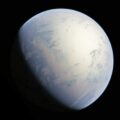Researchers from Brown University studying glass shards in the Atacama Desert of Chile have determined that it was almost surely caused by the explosion of a comet approximately 12,000 years ago.
Specifically, the researchers indicate that the glassification of the desert sand was caused by an airburst. This means that the comet itself exploded in the atmosphere rather than slamming into the Earth’s surface. Such explosions can cause the ground beneath the explosion to reach temperatures hotter than the sun and cause beyond hurricane-force winds.
BACKGROUND: PREVIOUS THEORY REFUTED
According to Gizmodo, previous research hinted that the glasses came from super-hot grass fires long before the area turned into a desert. However, the Brown team found a number of new pieces of evidence that lends significant support to their cometary impact theory.
“The Atacama is perfect for preserving the record,” said Peter Schultz, a planetary geologist at Brown University, told Gizmodo. “The difference between other glasses across the Atacama and these glasses is that our glasses are really large and indicate complex interactions between the airburst, heating, and winds.”
ANALYSIS: MINERALS AND COMPOSITION in Atacama Desert POINT TO COMETARY ORIGIN
In their analysis, the research team found that the mineral structure of the glasses showed evidence of being bent and transformed while still in a liquid state. This, they note, has been seen in other airburst models, and shouldn’t appear if the origin was from grass fires.
Second, the mineral composition of the glasses included troilite and cubanite. These materials, the researchers say, are similar to those sampled by NASA’s Stardust mission to the comet Wild-2, also pointing to an airburst of space rock rather than grass fires.
“Those minerals are what tell us that this object has all the markings of a comet,” said Scott Harris, a planetary geologist at the Brown University Fernbank Science Center and a co-author of the study, in a press release. “To have the same mineralogy we saw in the Stardust samples entrained in these glasses is really powerful evidence that what we’re seeing is the result of a cometary airburst.”
OUTLOOK: HUMANS MAY HAVE WITNESSED EXPLOSION
More tests are expected, but for now the Brown team is confident they have discovered the cause of the miles of glass shards covering the Chilean desert. And, the researchers say, it is even possible that someone was there to witness this astronomical event.
“There’s also a chance that this was actually witnessed by early inhabitants, who had just arrived in the region,” said Schultz in the same release. “It would have been quite a show.”
Follow and connect with author Christopher Plain on Twitter: @plain_fiction
